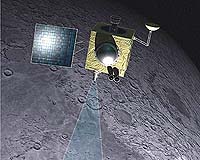 |
Paris, France (ESA) Sep 10, 2009 One of ESA's future Earth observation missions will monitor its orientation in space with the help of the smallest gyro ever flown by the Agency. Now being tested, the sugar cube-sized device at the heart of the gyro unit is derived from a sensor used in anti-lock braking systems on millions of cars. There is no up or down in space. Satellites track their pointing direction using the same approach as on submarines and aircraft: fast-spinning gyroscopes that maintain a fixed orientation in the same way as a child's spinning top. But space-quality gyros employing this principle are complex, bulky and insufficiently reliable for long space missions. "There have been several failures in orbit of these older mechanical gyros and their reliability became an issue," says Stephane Dussy of ESA's Control Systems Division. "They are now considered to be obsolete because more reliable gyros have been developed using solid-state technologies from other areas."
MEMS in their millions Attractive for space because of their small size, low power consumption and resistance to vibration, these micromachined devices may sound exotic but MEMS sensors are already used in their millions on European roads. In the last 15 years the automobile industry has adopted MEMS in a major way. The devices are embedded throughout modern cars: MEMS accelerometers trigger airbags, MEMS pressure sensors check tyres and MEMS gyros help to prevent brakes locking and maintain traction during skids. In a project funded by its Basic Technology Research Programme (TRP) and General Support Technology Programme (GSTP), ESA selected a particular MEMS gyro to modify for space use: the silicon-based SiRRS-01, manufactured by the UK's Atlantic Inertial Systems Limited (AIS), formerly part of BAE Systems. Scotland's Selex Galileo is prime contractor for the industrialisation phase, while English company SEA was the prime for the initial development phase.
'Singing' like a wine glass "The gyro works in the same way," explains Mr Dussy. "Its silicon ring is vibrated just like the wine glass, and any shifts in vibration are measured to derive its rotation rate."
Hardened for space This meant proofing the device against launch stresses and space radiation, as well as substituting space-proven electronic components for standard off-the-shelf parts. In the process of development this variant MEMS gyro, dubbed SiREUS, more than doubled in size from just 4x4 mm to a still-compact 10x10 mm.
Put to work Once qualified, SiREUS will become available to other space missions, Mr Durrant explains: "We have succeeded in providing a product with significant operational and cost benefits to future space projects, with the next phase resulting in a unit qualified for future operational use." "ESA provided the critical funding to cross from a 'breadboard' engineering model to one qualified for space use, which could not been justified on purely commercial terms. It has also enabled us to achieve a performance far in excess of previous MEMS rate sensors."
Sentinel-3 Share This Article With Planet Earth
Related Links GMES Preparatory Activities (GPA) Space Technology News - Applications and Research
 'Heat Stroke' Caused India's Lunar Probe To Fail
'Heat Stroke' Caused India's Lunar Probe To FailNew Delhi, India (RIA Novosti) Sep 08, 2009 India's first lunar mission may have failed as a result of overheating, a national daily reported on Monday. Chandrayaan-1 was launched in October 2008 and its main mission was conducting geological mapping of the Moon's surface aimed at producing a complete map of the chemical characteristics and 3-D topography. Chandrayaan means Moon Craft in Sanskrit. According to The Times of ... read more |
|
| The content herein, unless otherwise known to be public domain, are Copyright 1995-2009 - SpaceDaily. AFP and UPI Wire Stories are copyright Agence France-Presse and United Press International. ESA Portal Reports are copyright European Space Agency. All NASA sourced material is public domain. Additional copyrights may apply in whole or part to other bona fide parties. Advertising does not imply endorsement,agreement or approval of any opinions, statements or information provided by SpaceDaily on any Web page published or hosted by SpaceDaily. Privacy Statement |